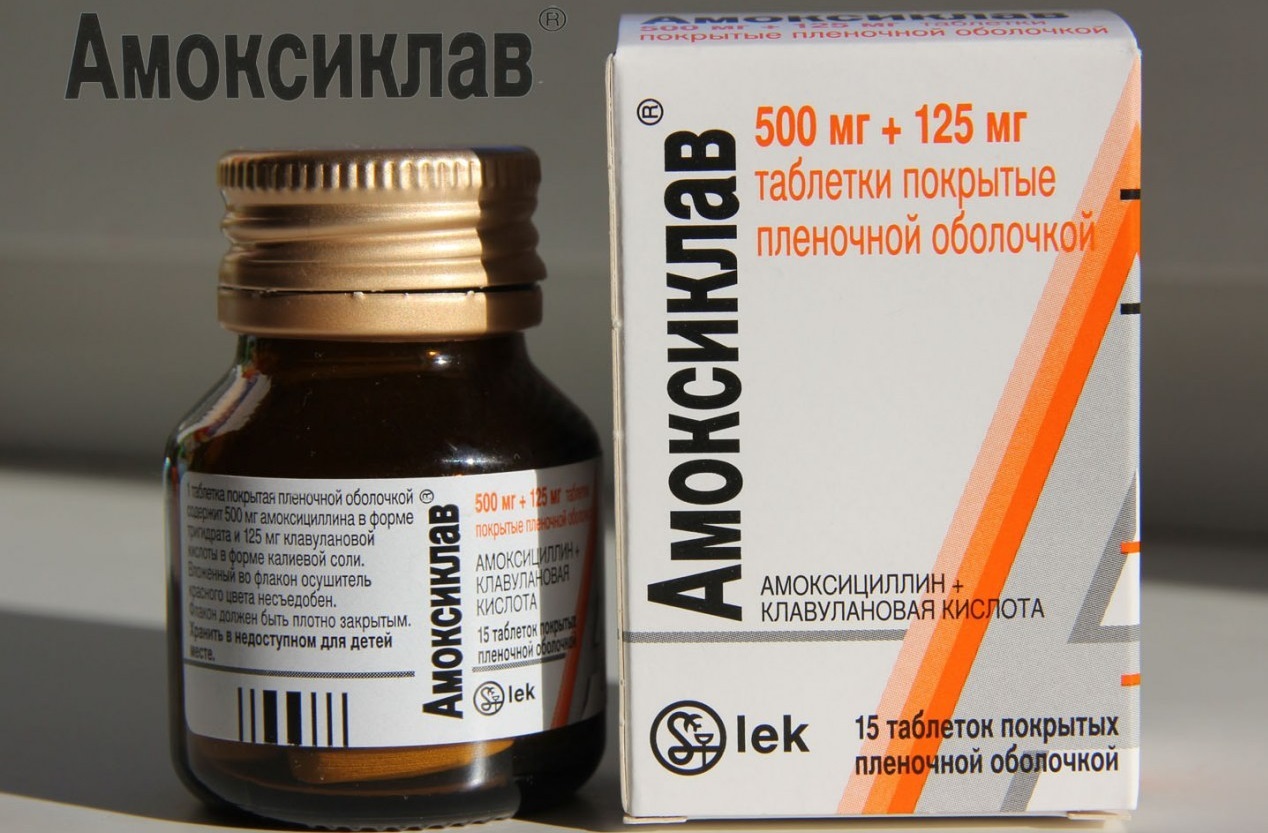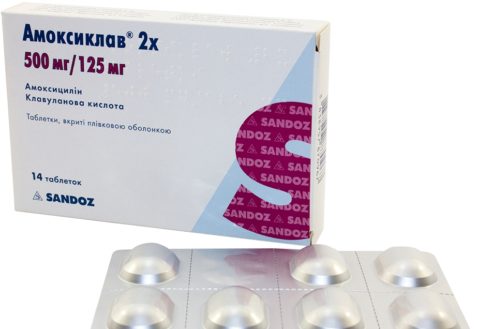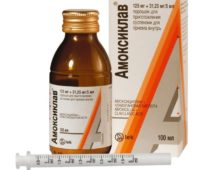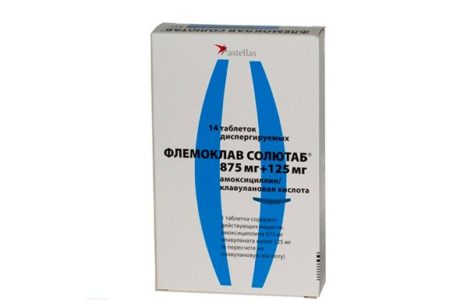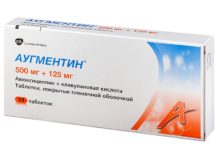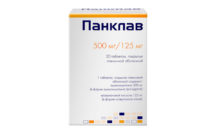Amoxiclav 500/125 belongs to the group of penicillin antibacterial agents used to combat many diseases caused by an infection of a bacterial nature. This is a complex medication, consisting of two components with antibacterial activity.
Material Content:
- 1 Release forms and composition of the antibiotic
- 2 Pharmacological action, pharmacodynamics and pharmacokinetics
- 3 In which cases Amoxiclav is prescribed
- 4 Instructions for use and dosage
- 5 During pregnancy and lactation
- 6 Drug interaction
- 7 Can I drink alcohol while taking the drug
- 8 Contraindications, side effects and overdose
- 9 Antibiotic Analogs
Release forms and composition of the antibiotic
Amoxiclav is a product of an Austrian pharmaceutical company.
The medication is available in the following forms:
- in tablets with a dosage of 250 mg / 125 mg with a thin intestine-soluble coating;
- in tablets with a dosage of 500 mg / 125 mg with enteric coating;
- in the form of tablets for resorption, dissolution in water - Amoxiclav Quicktab with a dosage of 500 mg / 125 mg;
- in the form of a powder, allowing to prepare a suspension for children;
- in powder form for intravenous injection.
The tablet form of Amoxiclav includes the following components that are active on the body:
- amoxicillin 500 mg;
- clavulanic acid 125 mg.
Tablets, in addition to active substances, consist of the following auxiliary components that do not have a therapeutic effect:
- cellulose;
- silica;
- polysorbate;
- titanium dioxide;
- magnesium stearate.
Amoxiclav Quiktab tablets, in addition to the active substances, consist of the following auxiliary ingredients:
- aspartame;
- silica;
- iron oxide;
- castor oil;
- flavorings.
Suspension, simultaneously with the active components, includes in its composition substances that do not have a therapeutic effect on bacteria:
- mannitol;
- sodium citrate;
- sodium saccharin;
- sodium benzoate.
Note. Powder for injections contains only active ingredients.
Pharmacological action, pharmacodynamics and pharmacokinetics
Instructions for use indicate the presence of the following pharmacological activity of Amoxiclav:
- penicillin-derivative drug has a bactericidal effect, disrupts the synthesis of cells. Thus destroying pathogenic microorganisms;
- clavulanic acid increases the effectiveness of amoxicillin. The second active component of Amoxiclav also has an antimicrobial effect;
- the medication is active to gram-positive anaerobes;
- the medicine is effectively taken with gram-negative anaerobes.
Amoxiclav quickly acts on pathogenic microorganisms. 60 minutes after its administration, the highest concentration of active ingredients in the plasma is determined. The active component of the antibiotic is absorbed into the circulatory system from the intestine, from where it spreads throughout the body. The drug is excreted through the urinary system within an hour.
In which cases Amoxiclav is prescribed
It is recommended to take Amoxiclav in the diagnosis of an infectious-inflammatory process.
Indications for prescribing a medication are:
- infectious ENT diseases;
- urinary infections;
- pathologies of the bronchi, lungs caused by infections;
- bacterial processes of the upper respiratory tract;
- gynecological infections, postpartum inflammation;
- infectious processes of connective tissues;
- bone disease;
- skin infectious diseases, post-burn conditions;
- inflammatory processes of bones, joints;
- infected abdominal processes;
- odotogenic infections;
- infection of the teeth, jaw;
- preoperative, postoperative period.
Important! Amoxiclav is taken only to eliminate the infection, which indicates sensitivity to the penicillin series.
Instructions for use and dosage
It is recommended to drink a penicillin-containing preparation after consultation with a doctor. It is important to determine the presence of bacteria sensitivity to antibiotics by conducting bacteriological studies. Recommendations on dosage, frequency of administration, duration of the treatment course are given individually. The condition of the patient, age, type of disease, its severity are assessed. Before starting treatment, you must make sure that there is no hypersensitivity to Amoxiclav. It is advisable to do an allergy test.
500 mg + 125 mg tablets
The tablet form of Amoxiclav is prescribed for adults, children over 12 years of age. In this case, the daily dose should not exceed 600 mg.
It is recommended to take the drug in the following conditions:
- uncomplicated pathology - 1 tab. four times a day;
- mild infection - 1 tab. twice a day;
- complicated course of the disease - 1 tab. up to 6 times a day;
- odotogenic infection - 1 tab. four times or twice a day.
If treatment is required for a patient who suffers from liver failure, then between doses it is necessary to increase the interval to 12 hours. In severe kidney disease, the interval between doses is recommended to be increased to 24 hours, provided that Amoxiclav is administered intravenously.
Therapy of the pediatric population is carried out by Amoxiclav in suspension, diluted to measure with distilled water. The permissible dosage per day is up to 45 mg of penicillin preparation per 1 kg of the child's weight.
Amoxiclav in injections
Amoxiclav injections are usually given intravenously. In exceptional situations, intramuscular injection is allowed, taking into account the following dose:
- over 12 years old, an antibiotic is administered at 1.2 g 3 times a day.Severe course is treated with a four-time injection;
- up to 12 years, dosage calculation is carried out individually, based on the weight of the child. For 1 kg of weight, 30 mg of Amoxiclav are four times a day;
- for babies up to 3 months, the dosage is calculated from 30 mg per 1 kg of the baby’s weight twice a day.
To prepare the injection, it is recommended to dilute the powder in 10 ml of purified water. The antibiotic should be administered slowly, no more than 3 minutes. And also drip intravenous administration is possible. Then the input time is increased to half an hour.
Important! The prepared powder for injections must be administered within 15 minutes. The finished solution should not be frozen.
If after 2-3 days after the start of treatment the expected result is not observed, then a replacement of therapeutic tactics with a change in the medication group is necessary. Amoxiclav has proven effective solely for bacterial infections.
During pregnancy and lactation
Amoxiclav is prescribed for pregnant women only if the expected benefit to the expectant mother is higher than the expected harm to the baby. Conducting antibiotic therapy in the first trimester is especially harmful.
In the second, third trimester, the medication is prescribed subject to exact adherence to the dose. During breastfeeding, the drug is not used. This is due to the fact that its active components enter the baby’s body through breast milk.
Drug interaction
With the parallel administration of Amoxiclav with some groups of medicines, the following undesirable reactions may occur:
- with ascorbic acid, antibiotic absorption is accelerated;
- with laxatives, a slowdown in absorption is noted;
- with non-steroidal anti-inflammatory drugs, an increased concentration of Amoxiclav is observed;
- with anticoagulants, the effectiveness of antithrombotic agents decreases;
- with rifampicin, the antibacterial effect is weakened;
- with tetracyclines, the effectiveness of antibiotic therapy is reduced;
- with oral contraceptives, a decrease in their effectiveness is possible.
Can I drink alcohol while taking the drug
The simultaneous administration of Amoxiclav even with low-alcohol drinks is prohibited. This can lead to an increase in negative effects on the liver, an increase in the number of side effects.
Contraindications, side effects and overdose
Before using Amoxiclav, the following contraindications should be considered:
- jaundice;
- lymphocytic leukemia;
- mononucleosis;
- an allergic reaction to penicillin-containing drugs;
- liver disease;
- kidney disease.
If there is hypersensitivity to the active ingredients, the recommended dosage is exceeded, the frequency of use of Amoxiclav is increased, then the development of side effects in the form of:
- nausea
- decreased appetite;
- diarrhea
- vomiting
- abdominal pain;
- itching
- skin rash;
- puffiness;
- anaphylactic shock;
- dermatitis;
- jade;
- headache;
- dizziness
- convulsive condition;
- dysbiosis causing a fungal infection;
- bacterial resistance.
Cases of overdose lead to increased side effects, the severity of their manifestations increases. Usually an incorrectly calculated dose of Amoxiclav causes vomiting, diarrhea, and nervous excitement. More severe situations are accompanied by convulsions. If after overdose symptoms appear, then you should call a doctor, do a gastric lavage, take activated charcoal.
Antibiotic Analogs
Amoxiclav has domestic and foreign analogues in active components.
To replace, it is recommended to take the following drugs with a wide spectrum of action:
- Renclave;
- Amoxivan;
- Flemoklava;
- Augmentin;
- Panklava.
Amoxiclav replacement should be performed by a doctor, as well as the calculation of the recommended dosage and frequency of administration.
Amoxiclav antibiotic therapy helps fight various infections. The medicine is usually well tolerated by patients of different age categories.


